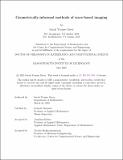Geometrically-informed methods of wave-based imaging
Author(s)
Greer, Sarah Yvonne
DownloadThesis PDF (6.627Mb)
Advisor
Demanet, Laurent
Terms of use
Metadata
Show full item recordAbstract
In this thesis, we are interested in understanding and advancing wave-based imaging techniques defined by the adjoint-state method. Wave-based imaging uses wavefield data from receivers on the boundary of a domain to produce an image of the underlying structure in the domain of interest. These images are defined by the imaging condition, derived from the first-order adjoint-state method, which corresponds to the gradient and maps recorded data to their reflection points in the domain. In the first part, we introduce a nonlinear modification to the standard imaging condition that can produce images with resolutions greater than that ordinarily expected using the standard imaging condition. We show that the phase of the integrand of the imaging condition, in the Fourier domain, has a special significance in some settings that can be exploited to derive a super-resolved modification of the imaging condition. Whereas standard imaging techniques can resolve features of a length scale of λ, our technique allows for resolution level R ă λ, where the super-resolution factor (SRF) is typically λ{R. We show that, in the presence of noise, R „ σ. In the second part, we investigate the Hessian operator, which arises from the second-order adjoint-state method, in the context of full-waveform inversion, a non-linear least-squares problem for estimating material properties within the domain of interest. We analyze the contributions of reflected and transmitted waves to the linearized Hessian operator, demonstrating that reflected waves generally produce a high-rank component with well-distributed eigenvalues, while transmitted waves contribute to a low-rank component with poorly distributed eigenvalues. This decomposition of the Hessian, motivated by the underlying physical system, provides insights that can be used to improve inversion strategies. The advancements in both parts of this thesis leverage the underlying structure and geometry of the domain of interest, providing the foundation for the zero-phase imaging condition in the first part and informing the decomposition of the Hessian operator in the second part.
Date issued
2025-05Department
Massachusetts Institute of Technology. Department of Mathematics; Massachusetts Institute of Technology. Center for Computational Science and EngineeringPublisher
Massachusetts Institute of Technology